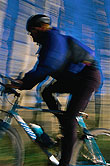
THURSDAY, Feb. 17 (HealthDay News) — Cyclists using special bike-only tracks that are physically separated from street traffic have fewer accidents compared to bikers pedalling alongside motor vehicles, a new study finds.
“We found that there is a 28 percent lower injury rate when bicycling on cycle tracks, compared with bicycling in parallel and comparable roads,” noted study lead author Anne Lusk, a research associate in the department of nutrition at the Harvard School of Public Health in Boston.
“Of course, intersections do have to be well-designed, ideally with red and green bicycle signals,” Lusk added. “And even then, we’re not suggesting that cycle tracks have zero risk. But rigorous research does show that the difference in the accident rate is real.”
Lusk and her team report their findings in a recent issue of Injury Prevention.
According to the National Highway Traffic Safety Administration, about 51,000 American cyclists suffered injuries as a result of encounters with motor vehicles in 2009, with such accidents accounting for two percent of all traffic fatalities in the United States (according to 2008 figures).
So it’s not surprising that surveys have consistently shown that many American cyclists — particularly women, seniors, and parents who cycle with their children — are afraid of pedaling on traffic-heavy roads.
Although designated bike lanes kept wholly separate from the road are a common feature in many other countries, they remain a relatively rare phenomenon in the United States. In the U.S, bike lanes typically consist of merely a painted stripe on the pavement delineating cyclists’ portion of the road.
In contrast, the Netherlands — a country half the size of South Carolina, with just under 17 million residents — is home to about 18,000 miles of separate cycle tracks, the researchers noted. By comparison, across the entire U.S. only about 20 miles of similar bike-only tracks are currently in place, mainly in centers such as New York City, Portland, Ore., and Seattle.
A lack of safe biking tracks might reinforce the car-centric culture that predominates in the United States, Lusk’s team said. While more than a quarter of all Dutch commuters get around by bike and 55 percent of Dutch cyclists are women, in the U.S. less than one-half of 1 percent of Americans ride a bike to work and fewer than one-quarter of those riders are women.
Differences in biking infrastructure are also accompanied by starkly different accident rates: cycle injury rates are at least 26 times higher in the U.S. than in the Netherlands, the researchers noted.
In their study, Lusk and her team focused on the safety profile of the urban bike lane system first set up two decades ago in Montreal, Canada.
Injury and crash rates for six cycle tracks in Montreal were compared with one or two alternative street routes per track. Tracks and alternate streets (which lacked biking lanes) were characterized as posing similar “traffic dangers” to riders in terms of the type, number, and speed of cars on the road.
All the cycle tracks featured two-way cycle traffic (going both with vehicular traffic and against it) on one side of the road, from which they were separated by raised pavement, parking lanes, and/or posts. Most of the alternate streets ran parallel to the cycle track roads, and came to the same end-point intersections as the tracks.
Local emergency response and police records were used to assess injury and crash occurrences between 2000 and 2008. Injury severity was not assessed.
The study found that 2.5 times as many bikers used the cycle tracks compared with street routes without separated bike lanes. But even with the increase in bike congestion, injury rates on the cycle tracks remained either lower than or similar to equivalent street routes, depending on the particular track.
And when they looked at all the cycle tracks together, the research team pegged the overall relative risk of injury as 28 percent lower on the separated tracks versus biking on a street in traffic.
“Based on the lower relative safety risk, we think that the construction of cycle tracks should not be discouraged,” Lusk said.
Susan Finn, chairwoman of the American Council for Fitness & Nutrition in Washington, D.C, said Lusk’s findings “all make sense,” given that the focus should be on encouraging, rather than discouraging, the biking habit.
“I’m not necessarily talking about those people who are tremendous athletes with great skills who can perhaps handle sharing the road with cars,” Finn noted. “I’m talking about those who would likely feel safer in a separated bike path, and therefore be more likely to actually get out and go biking in that kind of environment.”
“So if what we want is to motivate people to be active and safe, regardless of the level of expertise, then it seems to me that a designated cycle path would really serve the majority of people we want to see getting out there,” she added. “Those who maybe aren’t the jocks but who want to engage in purposeful activity.”
More information
For more on bicycle safety, visit the National Highway Traffic Safety Administration.

